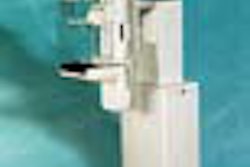NEW YORK CITY - GE Medical Systems broadened its digital x-ray product line February 29 with the introduction of Innova 2000, a flat-panel digital cardiovascular imaging system. Innova 2000 is the fourth GE digital x-ray system to be introduced that incorporates the company's Revolution flat-panel amorphous silicon technology.
GE made the announcement at a media event in New York City that highlighted Innova 2000 along with Senographe 2000D, a full-field digital mammography system that was cleared by the Food and Drug Administration in January. Although Senographe 2000D may ultimately prove to be more important to GE in the long run, Innova 2000 turned heads because the New York City event marked the first time information about the product had been released to the public.
As the first flat-panel digital cardiac cath system to hit the market, Innova 2000 offers a number of clinical benefits, including a dynamic range more than 10 times that of analog systems, according to Jeffrey Immelt, president and CEO of GE Medical Systems. This allows better visualization of arteries and characterization of tissue, he said. The system also generates half the radiation of conventional analog systems.
"It's a more efficient imaging procedure, which allows you to get better image quality and detection at a comparable dose level, or a reduced dose level (with) the same image quality," he said.
Innova 2000 also allows for easier inclusion of cardiac cath data into DICOM-compliant information systems such as cardiology and hospital information systems, Immelt said. Innova 2000 comes with advanced applications such as task-specific image processing, and supports outcomes tracking and analysis, Immelt said.
A researcher at one of GE's test sites agreed with the diagnostic potential for Innova 2000.
The system has allowed cardiologists at the Mayo Clinic to receive information from a cardiac cath study that wasn't possible before, according to Dr. David Holmes, Jr., director of the Adult Cardiac Catheterization Laboratory at the Rochester, MN-based Mayo Clinic. For example, interventional cardiologists using Innova 2000 were able for the first time to visualize stents after insertion, allowing them to ensure correct placement.
"If you have not achieved an optimal stent deployment, the chances of a patient having an optimal outcome are less," Holmes said. "They have more recurrent symptoms, more chest pain, (and) the potential for heart attack and the potential need for bypass surgery."
In addition, Innova 2000 allows cardiologists to more easily scan overweight patients, for which imaging of fine structures in the heart is a major problem. Also, procedure time is decreased because fewer images are needed, Holmes said. The unit is also more comfortable for patients, he added.
At a price of $1 million to $1.3 million depending on configuration, Innova 2000 will cost approximately 30% more than traditional cardiac cath systems, Immelt said. Innova 2000 includes a 20 cm x 20 cm detector and offers a frame rate of 30 frames per second. GE expects to sell 25 systems in 2000, as full production ramps up in the second half of the year.
GE received FDA 510(k) clearance for the system in mid-February. GE has invested more than $150 million in developing the Revolution detector technology that is used in Innova 2000 and Senographe 2000D.
By Erik L. Ridley
AuntMinnie.com staff writer
March 1, 2000
Let AuntMinnie.com know what you think about this story.
Copyright © 2000 AuntMinnie.com

















